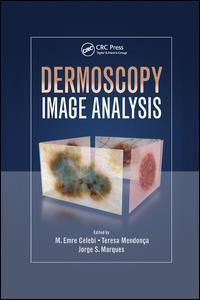Description
Dermoscopy Image Analysis
Digital Imaging and Computer Vision Series
Coordinators: Celebi M. Emre, Mendonca Teresa, Marques Jorge S.
Language: English
Subjects for Dermoscopy Image Analysis:
Keywords
Dermoscopy Image; ABCD Rule; Automatic Detection; Cad System; Bioinspired Color Representation; Pigment Network; Computer Vision-Based Systems; Color Space; Computer-Aided Diagnostics; HSV Color Space; Dermoscopic Color Images; Melanocytic Lesions; Dermoscopic Images; Atypical Pigment Networks; Dermoscopic Images Database; RGB Color Space; Dermoscopy; Pigmented Skin Lesion; Dermoscopy Image Analysis; Experienced Dermatologists; Dermoscopy Image Analysis Techniques; Dermoscopy Image Assessment; Reticular Pattern; Dermoscopy Images; Lesion Segmentation; Early Detection; Feature Selection; Global Pattern Classification; Skin Lesion Images; Image Analysis; Epiluminescence Microscopy; Image Analysis Techniques; Image Assessment; SVM; Image Processing Techniques; Reference Segmentations; Lesion Border Detection; Benign Pigmented Lesion; Localized Radial Flux; Border Detection; Malignant Melanoma; Blue White Veil; Medical Image Analysis; Samsung Galaxy S4; Melanocytic Skin Lesions; Expert Dermatologists; Melanoma; Melanoma Detection; Mobile Teledermatology; PH2; Perceptible Color Regions; Principal Intensity Curvature; Reticular Pattern Recognition; Skin Lesion Diagnostics; Streak Detection
Publication date: 11-2017
· 15.6x23.4 cm · Paperback
Publication date: 09-2015
· 15.6x23.4 cm · Hardback
Description
/li>Contents
/li>Biography
/li>
Dermoscopy is a noninvasive skin imaging technique that uses optical magnification and either liquid immersion or cross-polarized lighting to make subsurface structures more easily visible when compared to conventional clinical images. It allows for the identification of dozens of morphological features that are particularly important in identifying malignant melanoma.
Dermoscopy Image Analysis summarizes the state of the art of the computerized analysis of dermoscopy images. The book begins by discussing the influence of color normalization on classification accuracy and then:
- Investigates gray-world, max-RGB, and shades-of-gray color constancy algorithms, showing significant gains in sensitivity and specificity on a heterogeneous set of images
- Proposes a new color space that highlights the distribution of underlying melanin and hemoglobin color pigments, leading to more accurate classification and border detection results
- Determines that the latest border detection algorithms can achieve a level of agreement that is only slightly lower than the level of agreement among experienced dermatologists
- Provides a comprehensive review of various methods for border detection, pigment network extraction, global pattern extraction, streak detection, and perceptually significant color detection
- Details a computer-aided diagnosis (CAD) system for melanomas that features an inexpensive acquisition tool, clinically meaningful features, and interpretable classification feedback
- Presents a highly scalable CAD system implemented in the MapReduce framework, a novel CAD system for melanomas, and an overview of dermatological image databases
- Describes projects that made use of a publicly available database of dermoscopy images, which contains 200 high-quality images along with their medical annotations
Dermoscopy Image Analysis not only showcases recent advances but also explores future directions for this exciting subfield of medical image analysis, covering dermoscopy image analysis from preprocessing to classification.
Toward a Robust Analysis of Dermoscopy Images Acquired under Different Conditions. A Bioinspired Color Representation for Dermoscopy Image Analysis. Where’s the Lesion? Variability in Human and Automated Segmentation of Dermoscopy Images of Melanocytic Skin Lesions. A State-of-the-Art Survey on Lesion Border Detection in Dermoscopy Images. Comparison of Image Processing Techniques for Reticular Pattern Recognition in Melanoma Detection. Global Pattern Classification in Dermoscopic Images. Streak Detection in Dermoscopic Color Images Using Localized Radial Flux of Principal Intensity Curvature. Dermoscopy Image Assessment Based on Perceptible Color Regions. Improved Skin Lesion Diagnostics for General Practice by Computer-Aided Diagnostics. Accurate and Scalable System for Automatic Detection of Malignant Melanoma. Early Detection of Melanoma in Dermoscopy of Skin Lesion Images by Computer Vision-Based System. From Dermoscopy to Mobile Teledermatology. PH2: A Public Database for the Analysis of Dermoscopic Images.
M. Emre Celebi earned a B.Sc in computer engineering at the Middle East Technical University, Ankara, Turkey, in 2002. He earned M.Sc and Ph.D degrees in computer science and engineering at the University of Texas at Arlington, USA, in 2003 and 2006, respectively. A senior member of the IEEE and SPIE, he is currently an associate professor and the founding director of the Image Processing and Analysis Laboratory, Department of Computer Science, Louisiana State University, Shreveport, USA. Widely published, Dr. Celebi has worked on several projects funded by the U.S. National Science Foundation and National Institutes of Health.
Teresa F. Mendonça earned mathematics and Ph.D degrees at the University of Porto, Portugal, in 1980 and 1993, respectively. Currently, she is an assistant professor with the Mathematics Department, Faculty of Sciences, University of Porto, and a researcher at the Institute for Systems and Robotics–Porto. Her research interests are in the areas of identification, modeling, and control applied to the biomedical field. In recent years, she has been involved in projects for modeling and control in anesthesia and in medical image analysis.
Jorge S. Marques earned EE, Ph.D, and aggregation degrees at the Technical University of Lisbon, Portugal, in 1981, 1990, and 2002, respectively. Currently, he is an associate professor with the Electrical and Computer Engineering Department, Instituto Superior Técnico, Lisbon, Portugal, and a researcher at the Institute for Systems and Robotics, Portugal. He was the co-chairman of the IAPR Conference IbPRIA 2005, president of the Portuguese Association for Pattern Recognition (2001–2003), and associate editor of the Statistics and Computing Journal, Springer. His research interests are in the areas of statistical image processing, medical image analysis, and pattern recognition.
These books may interest you

Pocket Guide to Dermoscopy 47.10 €

A Practical Guide to Dermoscopy 102.81 €

Atlas of Dermoscopy 135.14 €

